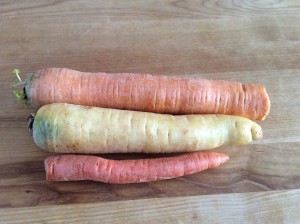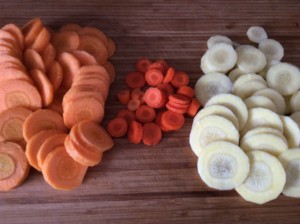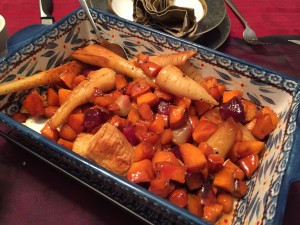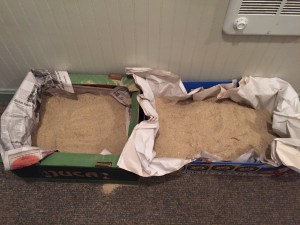» Jump to recipes using Carrots as an ingredient
Carrots-
Carrots are a root vegetable. They are very versatile, and used in both sweet and savory cooking preparations.
Both the greens and the roots of carrots are eatable. Carrots do not need to be peeled, but many people find the outer peel of a carrot to be bitter. Carrots can be eaten raw, and they lend themselves well to many cooking methods. Carrot tops work well in carrot top pesto.
Carrots come in purple, red, white, yellow. Using rainbow carrots in a dish makes a stunning presentation. The colors will fade when cooked.
For those storing the beets, carrots and parsnips, Farmer Jamie reminds us that a good way to preserve your root veggies is to give them a good rinse and pat dry when you get them home. Toss them in a ziploc bag in the fridge, and this will help to avoid the wilty wobbly veggies. Separate greens from the veggies right away too (such as with the radishes). If the bite of a radish is too much, you can cut them and leave them soaking in water in the fridge for a few days, and this will reduce the bite while keeping the veggies crisp.
For longer term winter storage, please see the root cellar options below.
Vitamin A, C, E, K, potassium, calcium, alpha and beta carotene, fiber

 On pickup day, foil is Jess’ go-to method of cooking root veggies for use in recipes throughout the week. The beets here were drizzled in olive oil and kosher salt. The carrots were drizzled in Ben’s Maple Syrup and a pat of Amish roll butter. The radishes were honey roasted.
On pickup day, foil is Jess’ go-to method of cooking root veggies for use in recipes throughout the week. The beets here were drizzled in olive oil and kosher salt. The carrots were drizzled in Ben’s Maple Syrup and a pat of Amish roll butter. The radishes were honey roasted.

This is what Jess has after roasting at 400 for a spell. The carrots and radishes were done faster. Don’t forget to save the radish tops to serve with the radishes! This was a quickie version of honey roasted radishes, but check out this version for the most delicious full Monty recipe.
—

Hi! Jess here again to talk about longer-term carrot storage for a moment. There are many methods out there for storage, and what I’m talking about below is one approach that works for me, however feel free to explore what will work best for you, your households’ temperatures, humidities, lifestyles, etc.
One method of storage is a root cellar. No, you do not need to build an addition on your house or go digging up your yard to have one (though you can if that’s how you roll). You may recall that last year I had 50 pounds of carrots stored throughout the season in a simple cardboard box setup, and the carrots lasted just about 6 months before we finished up the last of them- it was amazing!
Here is a simple root cellar setup.

Obtain a sturdy cardboard or wooden box.

Line it with paper.
Layer in your prepped root veggies. Veggies should be trimmed (of tops, but leave the “stubble at the top” or you can invite rot) and healthy (blemished veggies also invites rot). There is no need to pre-wash these, some dirt is a-ok. Next, cover them with sand (sawdust and potting soil also works- this year I’m using a 3 dollar bag of play sand) and repeat between layers.
Store in a cool (not below freezing but not warm) place (in my house, this is a three season mini-room off in the garage).

“Harvest” your veggies as desired. (Here I have a sandbox of beets and a box of carrots. In the cellar (my actual cellar, not the root cellar), I have my squashes stored in a crate. As the fall goes on, I’ll move into a second and possibly third crate.

I’ve been reminiscing about these rainbow carrots from the share box a year or three ago – they made such great witches’ fingers! The fingernails were almond slices and the homemade hummus was so creamy.
Recipes Using Carrots
This recipe is incredibly simple and flexible, just the way we like our recipes around here. Whether working with fresh or leftover chicken or turkey, this recipe is a pretty basic and tasty place to start. 2 prepared pie crusts can be used, or if you have some of the lovely winter CSA grains and a bit of extra time, a from-scratch pie crust is an option. Fresh or frozen (or both) veggies can be used in the filling as well.
Here we have a hearty soup using beef bones. Included are some plan-ahead options that make the soup even more flavorful, and also included are ways to fit this into a busy schedule and have steamy deliciousness waiting when you get home. Read through this post and decide what’s the best option for your schedule!
Chicken is an option for this soup too, if you are looking for more of a protein boost!













